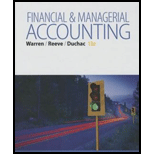
Concept explainers
Accrued Revenue:
As per the accrual concept of accounting all expenses and revenue of the business should be recorded in the period of their occurrence irrespective of the involvement of cash. Accrued Revenue is the revenue of the business which has been earned but not yet received at the end of accounting period. It is treated as an asset (receivable) for the business.
Adjusting entries indicates those entries, which are passed in the books of accounts at the end of one accounting period. These entries are passed in the books of accounts as per the revenue recognition principle and the expenses recognition principle to adjust the revenue, and the expenses of a business in the period of their occurrence.
Rule of Debit and Credit:
Debit - Increase in all assets, expenses & dividends, and decrease in all liabilities and
Credit - Increase in all liabilities and stockholders’ equity, and decrease in all assets & expenses.
To record: The given transaction as the adjustment entry for accrued revenues.
Want to see the full answer?
Check out a sample textbook solution
Chapter 3 Solutions
Bundle: Financial & Managerial Accounting, 13th + CengageNOWv2, 2 terms (12 months) Printed Access Card
- I want to this question answer for General accounting question not need ai solutionarrow_forwardBeethoven Ltd. has a profit margin of 6.1 percent on sales of $18,200,000. Assume the firm has total assets of $15,400,000 and total debt of $5,200,000. What is the firm’s return on assets (ROA)?arrow_forwardWhat was kandinsky net income for the year?arrow_forward
- Atwater Chemicals produces an engine additive for machinery. The additive is produced by adding various ingredients to a petroleum-based lubricant. Atwater purchases the lubricant from two suppliers, Woodlawn Petroleum and Spokane Chemicals. The quality of the final product depends directly on the quality of the lubricant. If the lubricant is "off," Atwater has to dispose of the entire batch. Because all lubricant can be "off," Atwater uses a measure it calls the “yield,” which is computed as Yield = Good output ÷ Input where the output and input are both measured in barrels. As a benchmark, Atwater expects to get 12 barrels of good output for every 16 barrels of lubricant purchased for a yield of 75 percent (= 12 barrels of output ÷ 16 barrels of lubricant). Data on the two suppliers for the past year follow: Woodlawn Petroleum Spokane Chemicals Total Total inputs purchased (barrels) 5,760 3,600 9,360 Good output (barrels) 3,744 3,096 6,840 Average price (per barrel) $ 121.00 $…arrow_forwardI am searching for the correct answer to this general accounting problem with proper accounting rules.arrow_forwardWatko Entertainment Systems (WES) buys audio and video components for assembling home entertainment systems from two suppliers, Bacon Electronics and Hessel Audio and Video. The components are delivered in cartons. If the cartons are delivered late, the installation for the customer is delayed. Delayed installations lead to contractual penalties that call for WES to reimburse a portion of the purchase price to the customer. During the past quarter, the purchasing and delivery data for the two suppliers showed the following: Bacon Hessel Total Total purchases (cartons) 5,000 3,000 8,000 Average purchase price (per carton) $ 168 $ 184 $ 174 Number of deliveries 40 20 60 Percentage of cartons delivered late. 30% 15% 25% The Accounting Department recorded $241,800 as the cost of late deliveries to customers. Required: Assume that the average quality, measured by the percentage of late deliveries, and prices from the two companies will continue as in the past. Also…arrow_forward
 College Accounting, Chapters 1-27AccountingISBN:9781337794756Author:HEINTZ, James A.Publisher:Cengage Learning,
College Accounting, Chapters 1-27AccountingISBN:9781337794756Author:HEINTZ, James A.Publisher:Cengage Learning, Financial And Managerial AccountingAccountingISBN:9781337902663Author:WARREN, Carl S.Publisher:Cengage Learning,
Financial And Managerial AccountingAccountingISBN:9781337902663Author:WARREN, Carl S.Publisher:Cengage Learning,- Century 21 Accounting Multicolumn JournalAccountingISBN:9781337679503Author:GilbertsonPublisher:CengagePrinciples of Accounting Volume 1AccountingISBN:9781947172685Author:OpenStaxPublisher:OpenStax College
 College Accounting (Book Only): A Career ApproachAccountingISBN:9781337280570Author:Scott, Cathy J.Publisher:South-Western College Pub
College Accounting (Book Only): A Career ApproachAccountingISBN:9781337280570Author:Scott, Cathy J.Publisher:South-Western College Pub





